A modern classic AND one of the most tunable cars on the planet – this Mazda MX-5 Miata Mk1 tuning guide shows you how to build one properly.
A slow, girlie, rusty, hairdresser’s car. That’s the stereotypes people so often say about the Mk1 MX-5/Miata, and while unfortunately we can’t argue against the fact they’re prone to more than a touch of rust, the rest – well, anyone who’s driven a well-tuned one would never say those things!
First appearing in 1989, the first generation MX-5, often known by its designation code ‘NA’, was Mazda’s modern interpretation of the classic lightweight roadsters of the past, which while not powerful, were the most nimble and fun cars you could get for their relatively low cost. Happily, Mazda got this recipe just right.
With double wishbone suspension at the front and rear, and a kerb weight of under 1000kg, the handling is fantastic even as standard. Plus, while it’s no powerhouse, the factory engines are revvy and capable, making these cars real giant killers on track with a few choice mods and a driver that really knows how to push the car to its limit.

The basics
With this car there really is no end of possibilities, but before anything else you want to truly decide what you want to do with the car, as a mish-mash of parts will just end up with an average result. These things make awesome road cars, track cars, drift cars, time attack cars, even drag racers. So, if you’ve got a specific goal in mind try and stick with that theme, as the parts list will be very different depending on what you’re planning to do with it.
What we will say though, is exploit its strong points, which are the light weight, great handling, and trouble-free engines. And because of this, don’t immediately jump in to engine mods if you want to go faster on track or drifting. If you do, you’ll find people with better handling or simply better driven MX-5s leaving you for dust despite your massive power advantage.
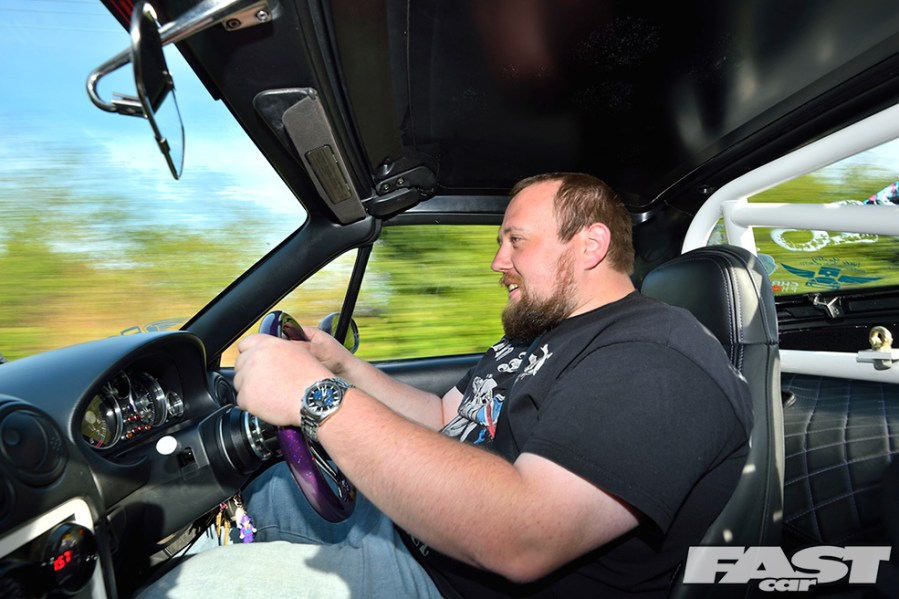
Driver mod
A controversial statement this may be, but this is coming from my own experience of owning six different tuned MX-5s, and using them all hard on track; THE best modification to an MX-5, more so than almost any other car in existence, is the ‘driver mod’. What I mean by that is you need to get better at driving the car, and spending time and money doing this will reap much bigger gains – especially in drifting and track use – than spending money on upgrades for the car itself.
I know everyone has the self-belief that they are a great driver who is able to get the most from their car, but nothing shows that isn’t true as much as an MX-5 can. There’s not a more common car on the planet where you’ll see lightly tuned ones with awesome drivers being giant killers on track, while more heavily modified ones being driven averagely are massively slower. And, to be honest, spending money becoming a much better driver is way more fun and satisfying than trying to mod your car to make it faster.

An MX-5 driver gets their line all wrong.
Here’s a few examples from my many years owning them
Firstly, I bought my first one because I’d already experienced friends with basic spec MX-5s on track being way faster than me and most others in ‘better’ cars; I’d seen it with my own eyes and there was no excuses, it was clearly how they were driven.
One of my MX-5s was a true piece of crap, and was stock aside from a bucket seat and a welded diff, even standard and very worn out shocks and springs. But despite that, I got voted driver of the day at a drift event I went to. I don’t think I’m an amazing driver, but it sure wasn’t the car that made it happen as it was the worst car there by far. Instead, I knew how to truly push it to the limits, and the limits on these things are amazingly high.

An MX-5 drift car spinning out.
I sold one of my standard engine MX-5s to someone who wanted a cheap car to learn to drift in as they didn’t want to ruin their Nissan Silvia, and as they’d seen pics and vids of mine in action they knew it was capable. This person sold it soon after, saying it didn’t have enough power to drift, despite knowing that wasn’t true.
When it comes to drifting, while they were never smoke machines as they didn’t have the power, because I knew how to exploit their limits I had no problem keeping up with or even undertaking at times people with drift cars with 3 or 4 times the power. You don’t need power to speed up if you never slow down! Watch this as proof.
Does power truly matter?
Finally, while it was an absolute rocket ship in a straight line, and the MX-5 I miss the most, my old one with a tuned Ford YB Cosworth 2-liter Turbo engine was, to be honest, no more fun than the others with a third of the power when on track.
Straight line acceleration needs power, but never have I known a car where power matters less for fun on track than a well driven MX-5.
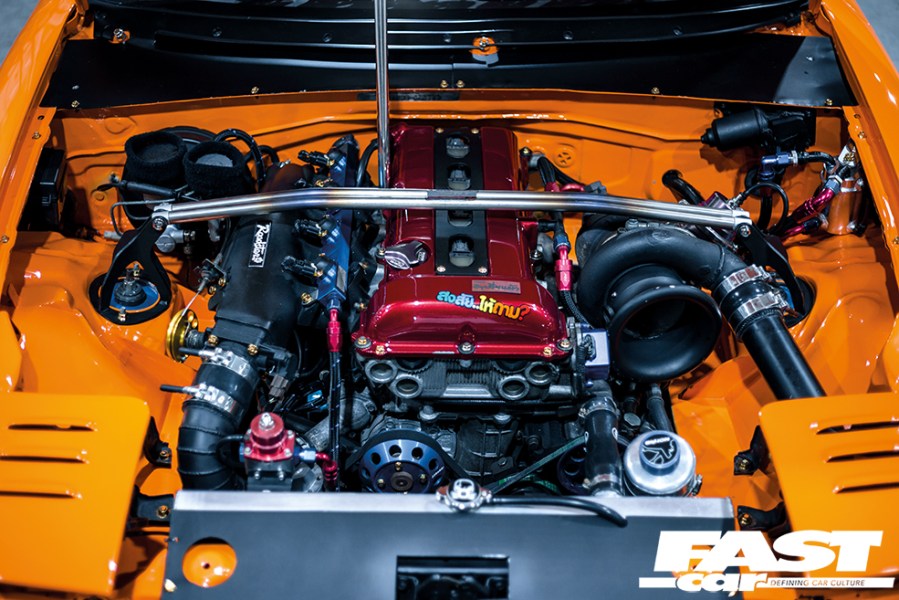
SR20 engine in a Mk1 MX-5
Engine swaps
It seems almost every MX-5 owner or even potential owner has an engine swap in their mind, and I’m guilty of it too, owning two in the past with non-Mazda engines fitted, and while it shouldn’t be top of your mod list, we need to talk about it as there’s so many awesome options.
Starting with the things with bolt-in kits available, the fact that LS and Ford V8s fit amazingly easily into the tiny MX-5s engine bay shows how much room you have for activities under the bonnet. And, with kits available, it’s one of the simplest ways to create a modern version of death machines like the legendary AC Cobra! Next up is the good old Honda K swap. The K-Series has been fitted to everything you can imagine, and the MX-5 is no exception, with full bolt-in kits available.
Less obvious it may be, but there’s actually bolt-in kits for a couple of V6 engines too, the Honda J-Series, which is a fantastic motor, and even the 3.6-liter V6 from late model Camaros which are over 320 horsepower with plenty of room to grow should you want more.
Away from the off-the-shelf kits, let’s face it, literally everything has been fitted to an MX-5 at some point, from V12s to 2JZs to quad rotors. So, we can’t give you a full list as it’s meaningless, but we can give you some pointers.
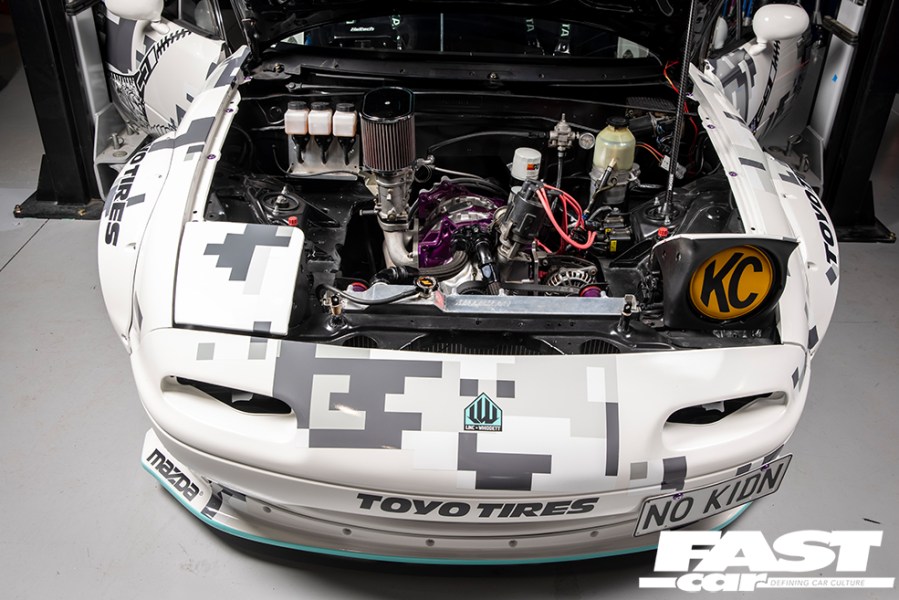
This MX-5 has been rotary-swapped
Best engine swaps
First up, while the bay is wide, it’s not particularly long, so although we’ve seen 2JZs and RBs fitted to MX-5s, an inline six is a tight squeeze and not the ideal swap for this little lightweight car.
Four cylinders fit the best of course, but due to steering rack and subframe position, some fit better than others. Rear sump engines fit with ease, but things with middle or front hump sump need significant mods to either the car or the engine to make fit nicely. Be aware, while modifying an engine’s oil system for a rear hump sump seems simple, we’ve seen a surprising amount of SR20 swapped MX-5s destroy their engines due to oil starvation very quickly because of this. It can be done, but it has to be done right.
In my personal opinion, I think the perfect engine swap for the MX-5 is a Wankel rotary. Lightweight, tiny, and incredibly free revving, it matches the MX-5’s characteristics perfectly. And, due to the lightweight nature of the car, even a naturally aspirated 2-rotor would be awesome fun and seriously quick. Fitment isn’t quite as simple as you’d imagine, again due to things like subframe and steering rack position, but it can and has been done, and it’s my personal number one choice.
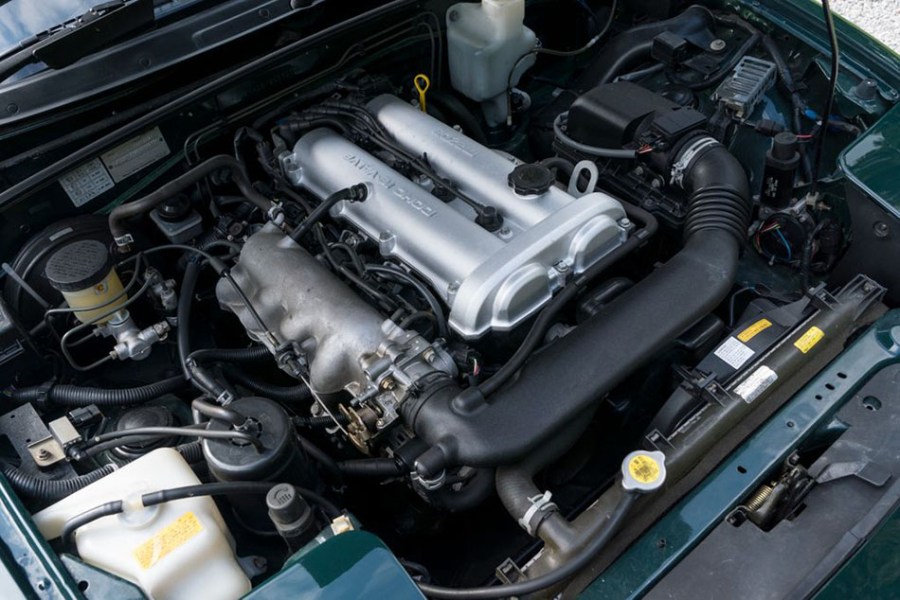
A standard Mazda B-Series engine.
Engine tuning
These cars got two versions of Mazda’s B-series engine, either a 1.6-liter 16V engine making 115-120bhp, or the 1.8-liter 16V making around 130bhp. While the 1.8 has a little more power and torque, the 1.6 tends to feel far more rev happy. My personal choice being the freer revving 1.6, despite the on-paper lower performance. That said, there is no bad option here, and when looking for maximum power from tuning, the 1.8 has a small advantage due to its larger capacity.
While the typical first mods of a performance exhaust and induction kit will give small gains, and the 1.6 can also gain worthwhile performance by advancing the ignition timing a little and, if you’re really determined, modifying the spring for the MAF housing flap. Don’t expect a rocket ship from these mods though. The improvement is relatively small, but noticeable, and proven gains up to stock 1.8 power and torque figures while keeping the revvy nature of the 1.6 is possible. For a 1.8-liter engine, while the exhaust and intake options are there, tweaking the timing and fueling isn’t as easy as with the 1.6, so performance gains are minimal.
If you’re determined to stick with a naturally aspirated and original engine, prepare to get your wallet out for worthwhile power increases. A fully built forged engine on ITBs and running big cams will rev beyond 8000rpm and make well over 100 horsepower per liter, but considering the cost, drivability, and reliability, your money is honestly better spent with forced induction or an engine swap.
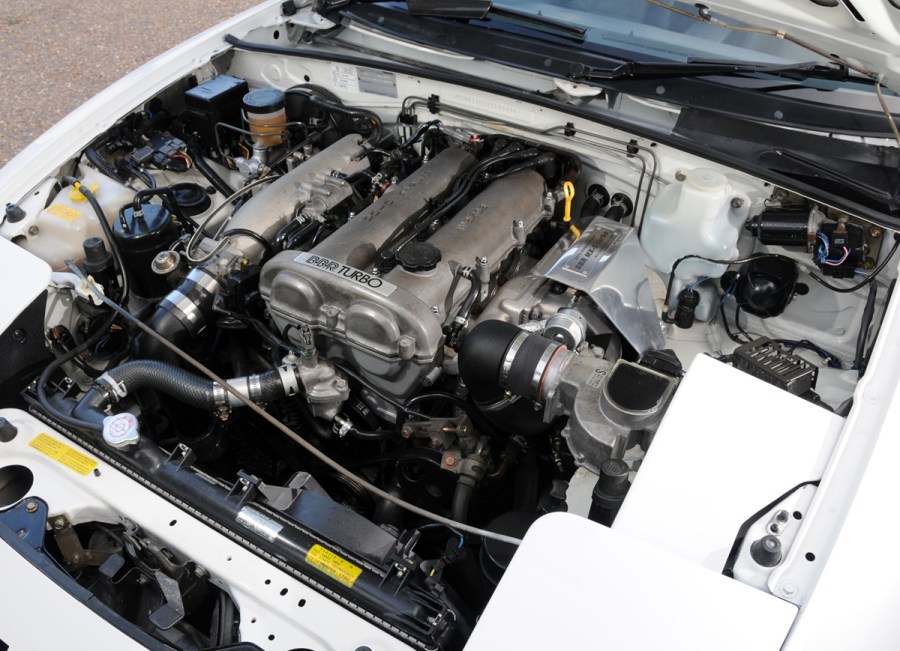
Turbochargers
Turbo and supercharger conversions are hugely popular on Mk1 MX-5s, and for good reason too, as the gains are massive for the money spent. Plus, the engines handle the power well; no doubt partly as Mazda offered both the 1.6-liter and 1.8-liter engines in turbocharged forms in other vehicles.
Your choice of forced induction is down to personal preferences and goals, as they are all good with no clear winner, and there’s plenty of off-the-shelf kits for every option, and countless more parts if you want to go custom.
Turbocharging gives the maximum power for your money, there is no question about that, and because of this it’s the most common form of forced induction. With a good ECU map that limits torque to help save the factory rods, 250 horsepower is considered quite reliable on standard internals with a turbo, though many cars push out even more.
The rods are the weakest point, but pistons, oil pump, and crank damper are all borderline beyond 250-300 horsepower. So, if you’re going to build an engine, you may as well do it all at once. The upper limit is high, well over 500 horsepower on both the 1.6 and 1.8, as the factory blocks and cranks are very capable, but it’s debatable if the money is better spent doing an engine swap when chasing numbers this high.
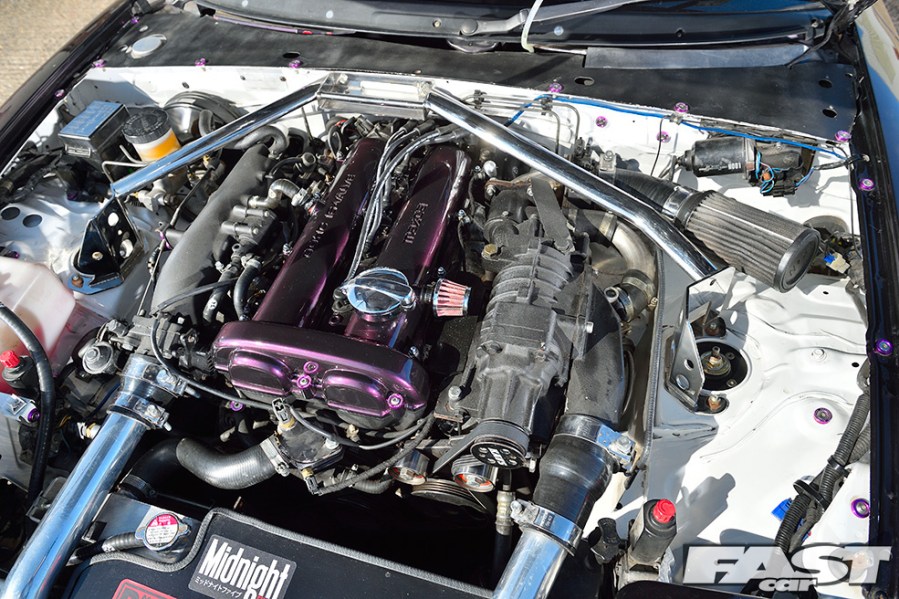
Positive displacement superchargers
For maximum point and squirt fun, if not maximum power numbers on the dyno, a positive displacement supercharger is the way to go. Their instant and lightning power delivery regardless of rpm really suits the fun and chuckable nature of the MX-5, and there are kits out there to fit the Eaton M45 supercharger which is good for about 240 horsepower, or the larger M62 if you are feeling particularly power hungry. Due to the less efficient nature of a positive displacement supercharger, power levels for any given amount of boost tends to be a little less than a turbo, but the way they deliver the power can often more than make up for it in many people’s eyes; mine included, and I’m a big turbo fan generally.
Centrifugal superchargers
The least common form of forced induction for the MX-5 is in many cases the fastest overall, and that is the centrifugal supercharger, most commonly a Rotrex unit. This conversion tends to cost the most, and power per psi tends to fall somewhere between the turbo and the positive displacement blower, but the completely linear way the boost increases from idle to the limiter gives a very smooth powerband with no drop-off no matter how far you rev it. This means there’s no sudden increases in torque that can spin the wheels, as can be the case with other forms of forced induction.
For a circuit racer, that can often mean faster times due to being able to be at full throttle for a greater percentage of the lap. This linear rising boost means you will have less midrange performance than a turbo or positive displacement blower, but it’s still a huge increase even from idle versus the naturally aspirated engine!
Regardless of your choice of power adder, a good aftermarket ECU is vital, and if you don’t fancy a full custom wiring loom, there are a wide variety of plug-and-play ECU options for the Mk1 MX-5.

Transmission
Designed to be enjoyable to use rather than to handle large amounts of power, the MX-5’s transmission has a fantastic gear change and more often than not comes with a limited slip differential as standard. Thankfully, it’s all very easy to upgrade too.
The most obvious weak point is the standard differential on the 1.6-liter models, which is fine at standard levels of power and normal use, but beyond around 180 horsepower, and in fact far less on very hard used cars, it’s only a matter of time until it fails. Luckily the far stronger 1.8-liter rear diff and driveshafts are a direct and simple swap, and this often has the added bonus of having a Torsen limited slip differential fitted rather than the often worn and relatively ineffective viscous LSD usually fitted to the 1.6 models.
While the 1.8 clutch is a little larger and stronger than the 1.6, neither can handle large increases in power, so an uprated clutch when going for even mild amounts of forced induction is needed. There are many variations out there, but to help preserve the life of the gearbox, using one with a sprung clutch plate is considered a wise move.
While not particularly strong, the factory five-speed boxes have been known to handle 250 horsepower with relative reliability if used along with a good shockproof gear oil, and for big power cars a swap to the 6-speed unit from later MX-5s is relatively simple. While they’re not considered to have such a nice shift feel as the five-speed, they are known to live even when over 400 horsepower is being put through them.
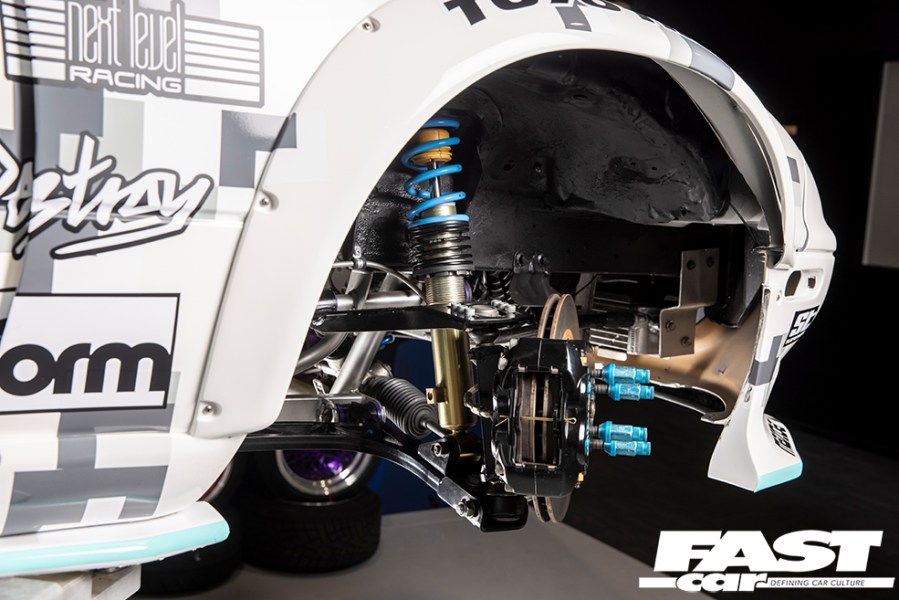
Suspension
This area is the MX-5’s strongest point, with great handling and an amazing amount of suspension geometry adjustability as standard; but that’s not to say it can’t be improved.
The go-to options
The most obvious first step is uprated shocks and springs, be it separate units or coilovers, and there’s a massive range out there for all budgets. Being such a lightweight car means suspension stiffness has a more noticeable effect than on most cars, and overly stiff suspension can upset the cars handling very easily over uneven road surfaces, meaning you don’t get the result you hoped for from this upgrade. For high-speed use on smooth circuits, much stiffer suspension is needed in comparison to softer road-orientated suspension, so it’s worth speaking to experienced MX-5 experts about your goals when choosing exactly what kit and what spring rates you want.
Another important upgrade, arguably as important as the shock and spring upgrade, is stiffer anti-roll bars. As well as allowing more fine tuning of the cars under and over steer characteristics, the main advantage is these allow you to prevent body roll without the need to run overly stiff springs, effectively giving you the best of both worlds; compliance over rougher surfaces and a lack of body roll during high speed cornering.

Other suspension tuning ideas
While they are available, aftermarket adjustable control arms are less commonly fitted to MX-5s because these cars have a good amount of camber and toe adjustment at both the front and rear from the factory. However, changing the factory rubber bushes on the stock suspension for polyurethane ones is certainly worthwhile to reduce play and make the car feel more responsive to your inputs.
Last but certainly no means least, especially for the drifters out there, are modified front hubs/knuckles. MX-5s have very little steering angle from the factory, and due to this have sometimes been named ‘washing machines’ due to how easy they spin out when drifting. And while the number one fix for this is the aforementioned ‘driver mod’, there’s no getting past the fact some more steering angle really does help. Due to the various changes these aftermarket hubs have, not only do you get more steering angle, but you also get very noticeably quicker steering. Plus, they can even help reduce bump steer, often making them a valuable addition even on non-drift cars.
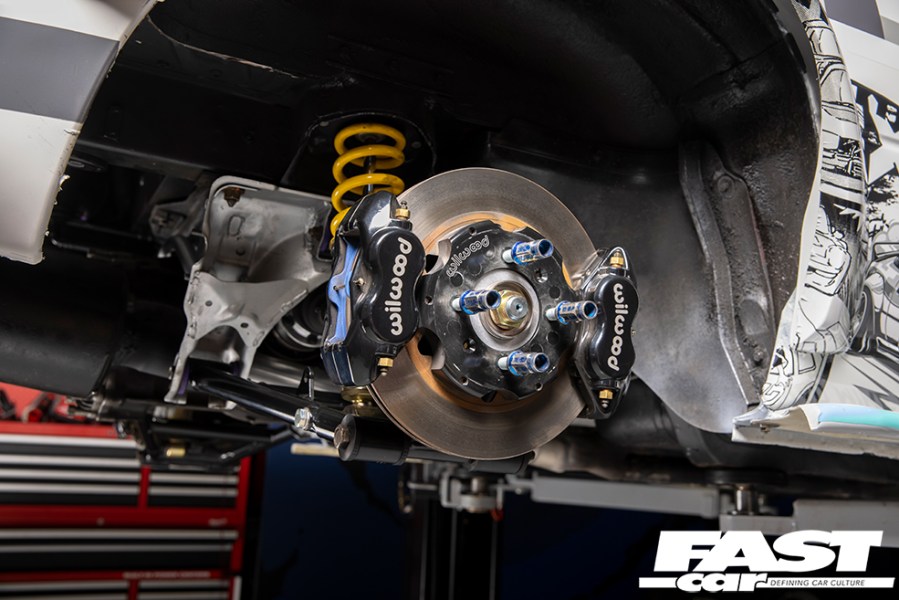
Brakes
There’s no doubt the factory MX-5 brakes – both the 1.6 and the slightly larger 1.8 versions – look pretty puny, but we have news for you; they’re amazingly capable after some very basic upgrades.
Thanks to the MX-5s light weight and Mazda’s overall good choices on brake selection, a simple brake pad upgrade at the front and rear is enough for most cars even with hard track use. Some track-spec brake pads, braided brake hoses, fresh and good quality brake fluid, and a brake master cylinder brace is enough for most cars to have some seriously impressive stopping power despite factory discs and calipers. Even many MX-5 race cars run the factory 1.6-liter setup as their light weight and stopping power was found to make for faster lap times even over larger and technically more powerful brakes.
Should you want to go bigger, there are plenty of options out there with big brake kits from various manufacturers, but it is well worth considering any weight increase this may also bring. Some BBK setups very notably increase the unsprung mass of the car (which is the enemy of performance) and offer no proven improvement in braking performance, despite the far more impressive looks.
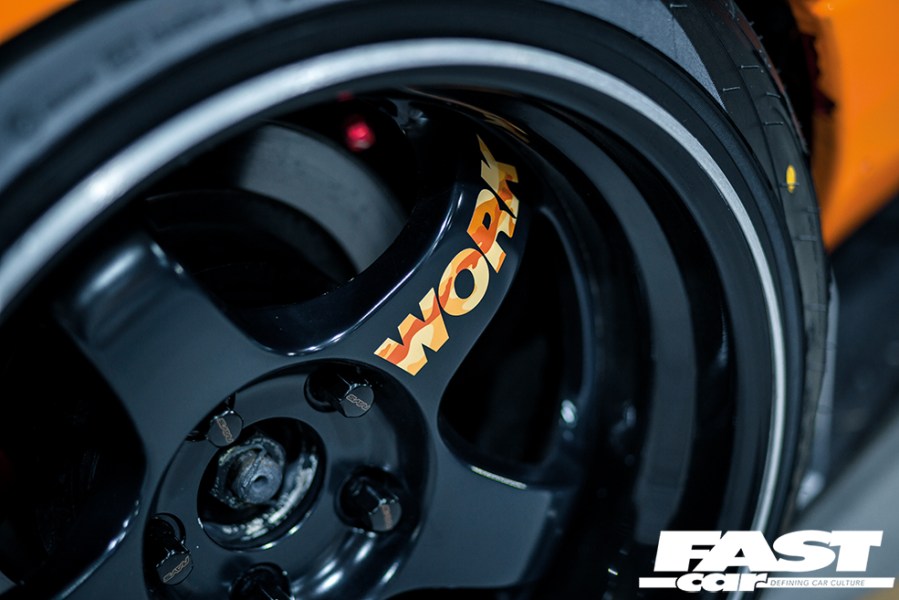
Wheels and Tires
The factory 14in ‘daisy’ wheels and skinny tires aren’t what you’d call good looking or high performance, so a wheel and tire upgrade is usually high on the list of priorities.
The MX-5 has the common 4×100 stud pattern, and while the factory wheel offset is high, fitting a very typical ET25-35 offset 7 or 8 inch wide wheel with 195 or 205 wide tires is no problem with standard wheel arches. While these tire sizes would be considered very narrow for most modern cars, this gives a serious amount of grip with a high performance tire on a Mk1 MX-5.
Should you want to go further, be warned that anything bigger than a 15-inch diameter wheel tends to make the MX-5 look like a rollerskate, but going much wider with both wheels and tires is surprisingly simple. With rolled and pulled arches, or some of the wide variety of bolt-on arch extensions out there, even 10×15 alloys and 275 wide tires have been fitted to some Mk1 MX-5 track cars. That said, the general consensus is the ‘ultimate’ overall track wheel and tire combo is 9x15s and some super sticky 225 wide track tires.
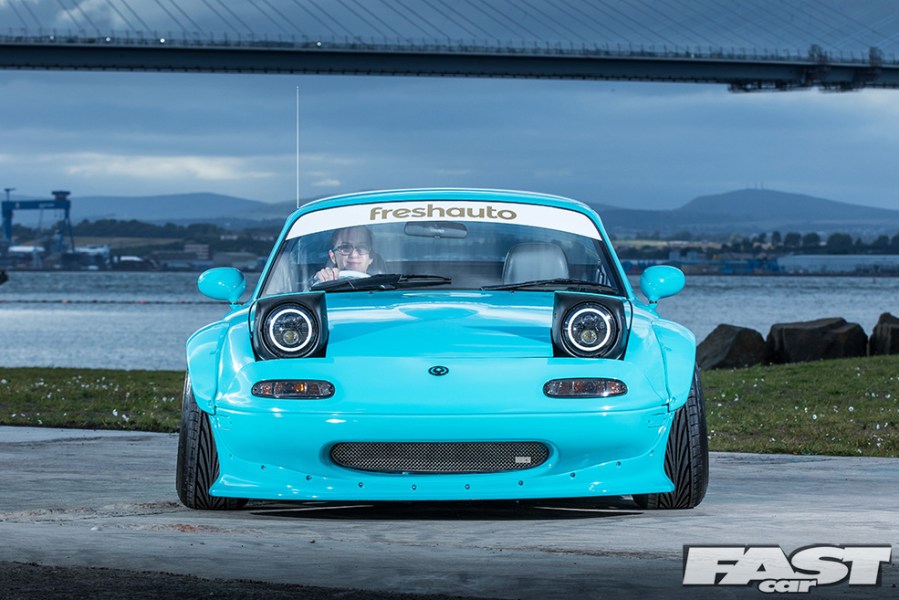
Body/Exterior
One of the main performance advantages of the Mk1 MX-5 is the lack of weight, and you can capitalize on that by making it even lighter! While things like the factory bonnet are aluminum, the fact that fiberglass or even carbonfiber versions are available for literally every single panel on the car, including the doors, means you can take weight reduction to the extreme should you wish.
The importance of airflow increases as you also increase power and speed, but thankfully there’s a wide variety of aero mods out there for this car, from front splitters and rear wings all the way to full flat floor kits. These cars are so popular as race cars that almost everything you could ever want is available off-the-shelf!
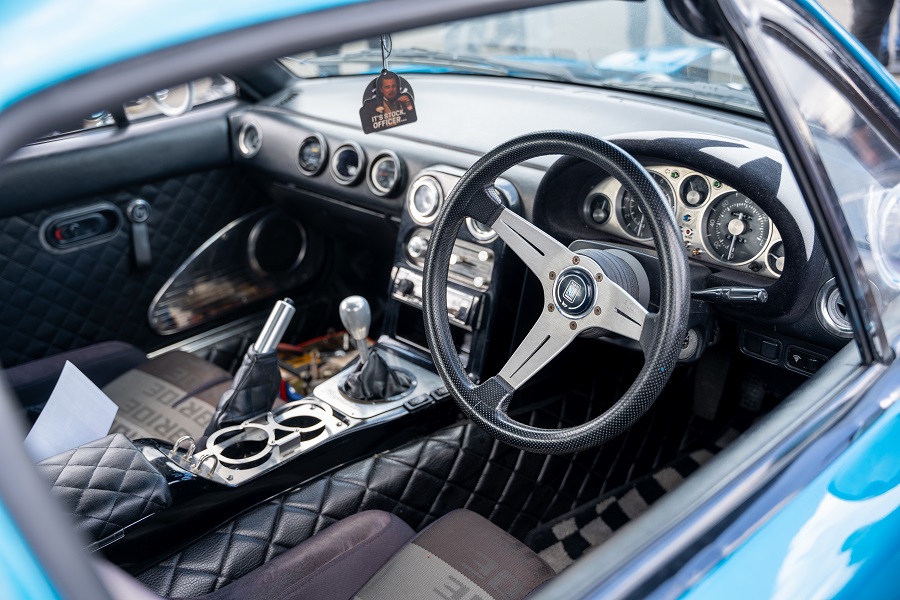
Chassis/Interior
Seats
One of the most effective single modifications to any hard-driven track MX-5, even on standard suspension and tires, is a driver’s bucket seat. The factory seat is nowhere near as supportive as you need to truly take full advantage of even the standard car’s cornering ability, and fitting a bucket seat allows you to concentrate all your efforts into driving rather than preventing yourself from falling out the seat! There are off-the-shelf mounts to fit bucket seats directly to MX-5s, though even the factory seat subframes are easily adaptable should you wish.
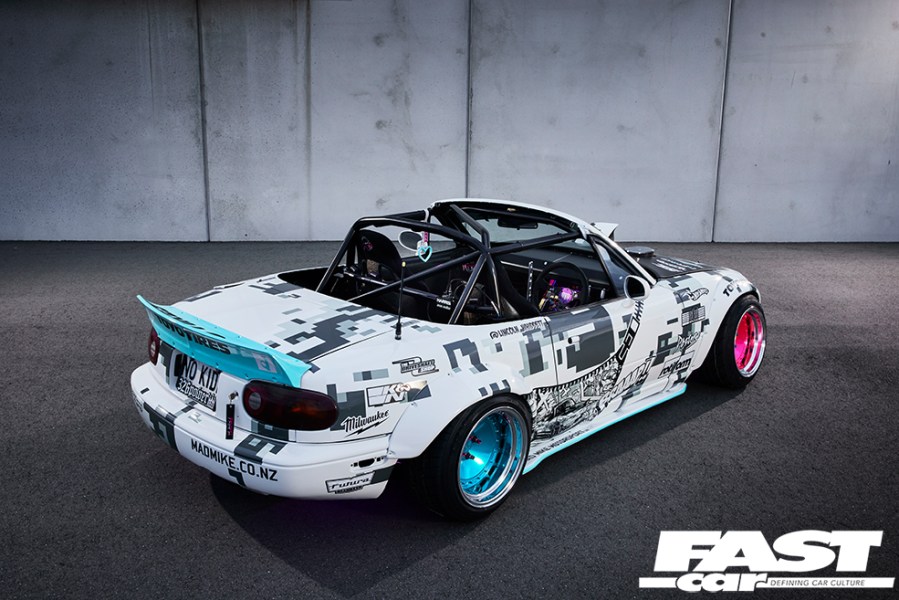
Bracing
While it’s far from bad, no roofless car is as stiff as the equivalent weight car with a roof, but there’s a huge amount you can add to stiffen things up. Before you start bolting things on you have to bear in mind the weight increases, and weigh up the positive effects of the bracing vs the negatives of adding weight to the car.
1.8-liter cars have a little more bracing from the factory, but are also heavier partly due to this, and it’s down to personal opinion (which includes the placebo effect!) on how effective the extra bracing is. There is countless aftermarket braces available for the strut towers, front and rear suspension, front wings, underbody braces, half cages and full roll cages, but what we will mention in more detail is a couple of slightly unusual things that add almost no extra weight but certainly do increase chassis stiffness.
Firstly, chassis rail reinforcement plates. They are alloy plates that bolt over the relatively soft factory chassis rails and are universally accepted to noticeably improve chassis feel. The second tip is replacing the factory rubber door bushes with solid delrin versions. This takes minutes and is very cheap, but it eliminates the ability for the door to flex, which in turn stiffens the whole chassis.




